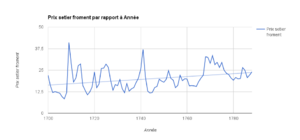Pacte de Famine facts for kids
The Pacte de Famine (pronounced "pakt duh fah-MEEN"), which means "Famine Pact," was a popular conspiracy theory in France during the 1700s. Many people believed that powerful groups were purposely hiding food, especially grain, to make themselves rich. At that time, most French people relied on grain for their daily meals.
Contents
Why People Believed It
This idea of a "Famine Pact" started to spread in France before the French Revolution. It became very strong in the 1760s and 1770s. For many French people, believing in this pact helped them understand the difficult political situation around them.
Between 1715 and 1789, the population of France grew a lot, from 22 million to 28 million people. This growth meant there was a much higher demand for food. However, there wasn't enough food to go around. Many people faced hunger and often got sick because of food shortages. Sometimes, people even blamed "bad grain" for making them ill.
King Louis XVI and Turgot
From 1715 to 1774, Louis XV was the King of France. During his time, many people suffered from hunger and other problems. The country needed big changes, but King Louis XV was criticized for not leading well enough to make them happen.
When Louis XV died in 1774, his grandson, Louis XVI, became king. Louis XVI wanted to bring order back to the kingdom. One of his first important decisions was to choose Jacques Turgot as his Finance Minister.
Turgot's Economic Ideas
Turgot believed in new economic ideas that were becoming popular in France. These ideas were called Physiocracy. The Physiocrats, also known as économistes, thought that a country's wealth came from its land and agriculture. They wanted to move away from older ideas where the government controlled trade very strictly.
Important thinkers like Dr. Francois Quesnay and Vincent de Gournay influenced Turgot. Gournay believed in "laissez-faire" economics, which means "leave it alone, let it pass." This idea suggests that the government should not interfere much with business and trade. Turgot strongly supported this "laissez-faire" principle.
Before becoming Finance Minister, Turgot had already tried out these free-market ideas in a smaller area called Limognes from 1761 to 1774. When he became Finance Minister, he wanted to bring these changes to the whole country. He worked to allow free trade in grain, improve France's money situation, and support farming and industry. He also wanted to get rid of old feudal privileges, which were special rights given to certain powerful groups.
Changes to Guilds and Grain Trade
To improve farming and the economy, Turgot made big changes to how things were produced and traded in cities. In 1775, he got rid of guilds and made the grain trade a free-trade system. He also removed many police rules that controlled businesses.
The Role of Police
In 18th-century France, the police did more than just enforce laws. They were also in charge of many parts of society, like keeping streets clean. People believed that all systems needed police to keep them in order. When Turgot changed the guild system, the police tried to get back control. They made it very hard for new businesses to get licenses, asking them to prove they were "moral and solvent." These were the very businesses Turgot wanted to open.
Public Reaction to Changes
Getting rid of the guilds made workers angry, and riots became common. Guild members argued that these changes would make people lose their sense of community and lead to chaos.
The changes to grain and bread supply caused even more problems. This conflict became known as the Flour War of 1775. Reports said there were problems with the grain harvest, leading to shortages and less grain available. The price of grain also went up, making it hard for many people to afford food.
People were suspicious of the grain shortage news and frustrated by the higher prices. Everyone, from the poor to government officials, felt that the problems with grain were not accidental. They believed it was done on purpose by powerful groups trying to make more money. People felt they were being taken advantage of while they were hungry.
Those who opposed Turgot's reforms rioted. They would stop grain shipments and offer what they called the "just price" for the grain, which was much lower than the market price. This act was known as "taxation populaire," or popular taxation. It was a way for people to take some power back.
Even though there were efforts to bring in more grain from other places, the belief in the "Famine Pact" continued. Stories and rumors about the conspiracy spread quickly. Even Turgot himself started to have doubts. He suspected that his political rivals were causing the unrest and bribing people.
What Happened Next
The widespread disorder was so severe that Turgot's economic experiment was stopped. He ended his time as Finance Minister in 1776. From 1775 to 1776, the police went back to regulating the grain trade. Guilds were also brought back, but they changed a bit because of the social changes happening in France.
France managed to get through these food shortages. Later, a new era of industrialization began, both before and after the French Revolution of 1789. Farming methods became more modern, and food production increased over the next century. This greatly improved the lives of many people in France.
See also
 In Spanish: Tasa de granos para niños
In Spanish: Tasa de granos para niños


